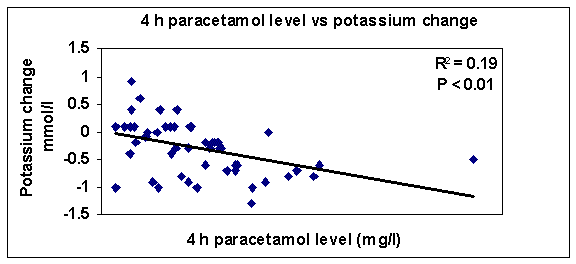| pA2 online © Copyright 2004 The British Pharmacological Society |
191P
University of Newcastle Winter Meeting December 2004 |
Effect of acute paracetamol overdose on changes in serum electrolytes N. Pakravan, A. J. Mitchell, J. Goddard1 & D. N. Bateman. NPIS Edinburgh, Scottish Poisons Information Bureau and 1Department of Renal Medicine, Royal Infirmary of Edinburgh, Edinburgh. |
|
Paracetamol is a widely available over-the-counter analgesic, which is frequently taken in overdose. It has some prostaglandin synthesis inhibitory actions [1]. In overdose NSAIDs, which also inhibit prostaglandin synthesis, can cause dose-dependent hypokalemia, increase fractional excretion of potassium and sodium retention due to renal vasoconstriction [2]. Therapeutic doses of paracetamol have no effect on potassium levels or excretion [3].
The aim was to study electrolyte changes in patients with paracetamol overdose.
A retrospective study was conducted on 60 patients with paracetamol overdose aged 16–65 years admitted to the toxicology ward of the Royal Infirmary of Edinburgh from 2000–2003. We excluded the effect of other drugs known to be nephrotoxic by history. The hospital laboratory system was used to extract biochemistry results taken at admission (4–6 h after ingestion), and again approximately 18 h later. Changes in electrolytes were correlated to admission paracetamol concentrations.
There was a significant negative correlation between admission paracetamol concentration (4–6 h concentration) (Figure 1) and fall in serum potassium: serum K+ change (y = –0.0021x + 0.0051, r2 = 0.19, P < 0.01). There was no change in serum sodium or creatinine. The mean fall in serum K+ in the quartile with highest paracetamol concentrations (mean 256 mg l-1) was –0.65 ± 0.16 mmol l-1.
Figure 1
4 h paracetamol concentration vs potassium change [AH1]

Paracetamol overdose is associated with hypokalaemia in proportion to the dose ingested, suggesting a specific renal effect of paracetamol in overdose. These findings could be consistent with increasing aldosterone action on the distal tubules as renal perfusion falls due to paracetamol-induced renal vasoconstriction.
1. Rang HP, et al. Pharmacology. Churchill Livingstone, 2003.
2. Goddard J, et al. J Toxicol Clin Toxicol 2003; 41 : 747 .
3. Prescott LF. Paracetamol: a critical bibliographic review. Taylor & Francis Ltd, 1996.